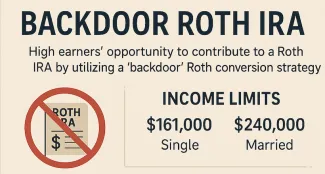
Unlocking Roth IRA Benefits for High-Income Earners: The Backdoor Roth Strategy Explained
If you're a high-income earner, you've likely run into income limits that block direct contributions to a Roth IRA. But there's good news: with a legal and IRS-acknowledged strategy called a "Backdoor Roth IRA", you can still enjoy the benefits of tax-free growth and withdrawals. Here's how it works—and why it may be worth considering.
1. Why Roth IRAs Are Valuable
- Tax-Free Growth: Contributions grow tax-free, and qualified withdrawals in retirement are also tax-free.
- No Required Minimum Distributions (RMDs): Unlike traditional IRAs, Roth IRAs don’t require withdrawals at age 73.
- Estate Planning Advantages: Assets can be passed to heirs tax-free, under current law.
2. The Income Limit Problem
For 2025, the IRS prohibits direct Roth IRA contributions if your modified adjusted gross income (MAGI) exceeds:
- $161,000 (single)
- $240,000 (married filing jointly)
This shuts many professionals and business owners out of direct Roth savings.
3. Enter the Backdoor Roth IRA
This strategy lets you bypass income limits using a two-step process:
Step 1:
Make a non-deductible contribution to a Traditional IRA (up to $7,000 in 2025, or $8,000 if you're over 50).
Step 2:
Shortly after (often within days), convert that contribution to a Roth IRA. Because the original contribution was non-deductible and you've made no investment gains, the conversion is typically tax-free.
4. Important Considerations
- Pro-Rata Rule: If you have other pre-tax IRA balances (Traditional, SEP, SIMPLE), the IRS will calculate the tax owed on the conversion proportionally, which can reduce the tax efficiency of this strategy.
- Timing: It's smart to convert soon after contributing to avoid investment gains that could trigger taxes.
- Form 8606: This IRS form reports non-deductible contributions and tracks basis in your Traditional IRA to avoid double taxation.
5. Who Should Consider It?
- High-income earners who don’t qualify for direct Roth contributions
- Savers who already max out 401(k)s and HSAs and want more tax-advantaged growth
- Investors comfortable managing IRS reporting or working with a financial advisor
6. Final Thoughts
The Backdoor Roth IRA is a smart, perfectly legal strategy that allows high-income earners to sidestep income limits and enjoy the long-term benefits of Roth accounts. Like any financial move, it’s wise to consult a tax professional before proceeding—especially if you have existing IRA assets.
Call to Action
Curious if the Backdoor Roth IRA is right for you? At TaxSavingStrategies.com, we specialize in helping high-income earners evaluate their retirement options and implement tax-smart strategies. Visit our site to learn more or schedule a consultation—we’re here to help you make the most of your money.

